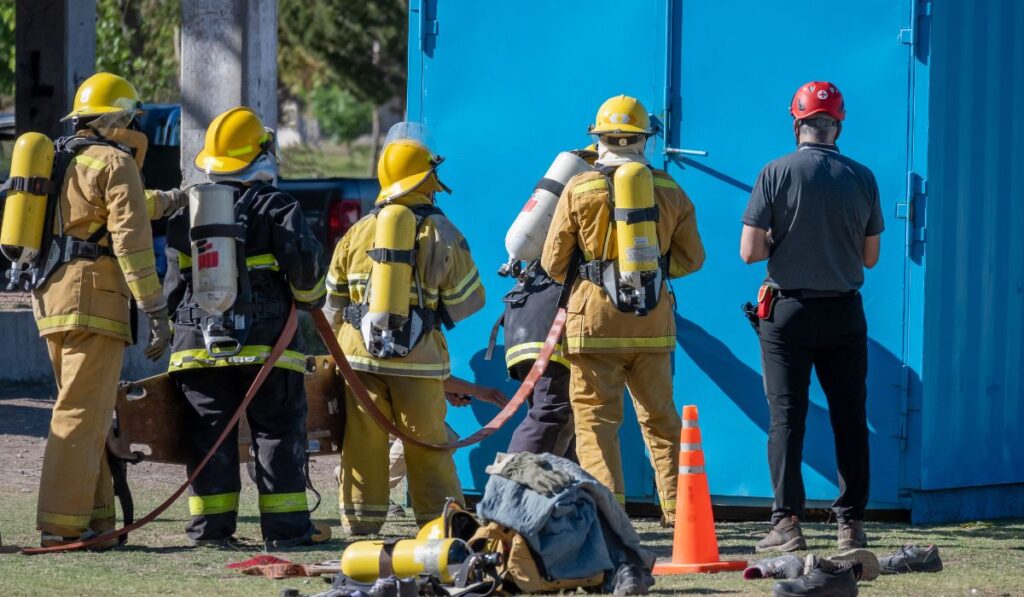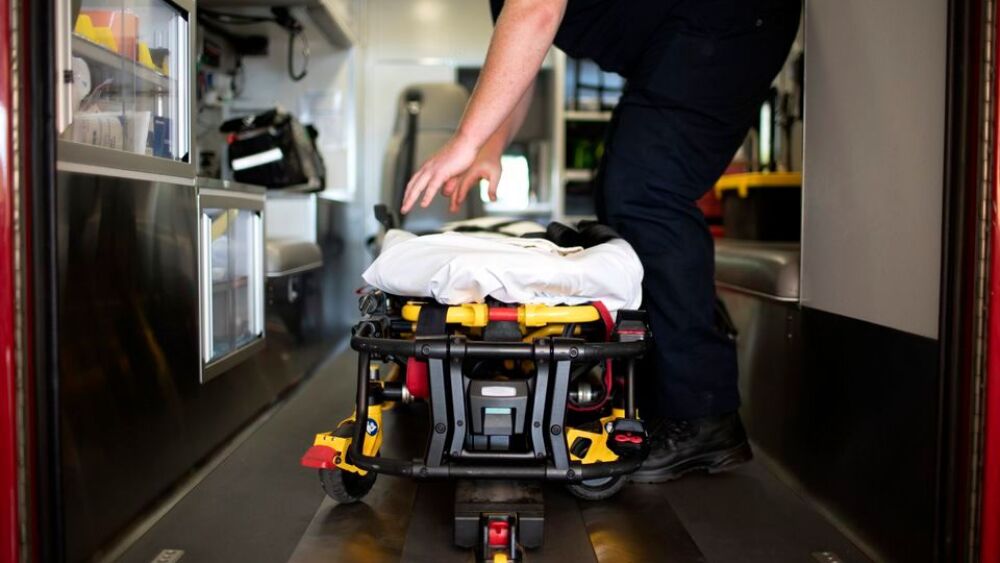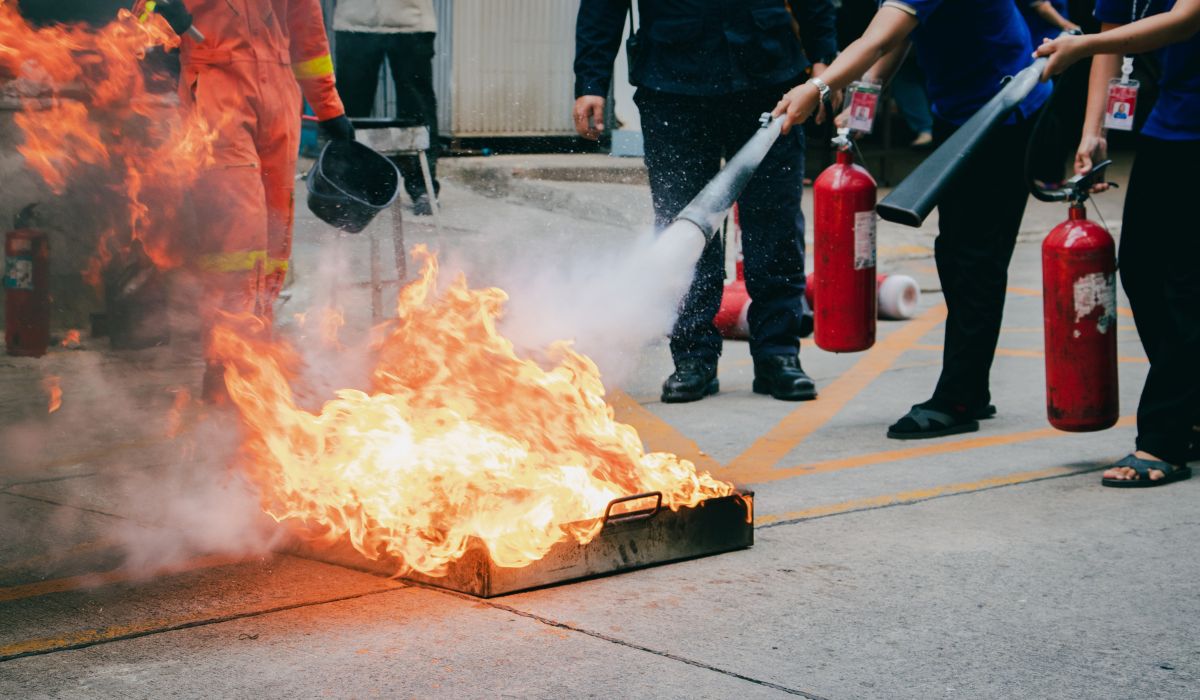Fire Detection Systems Training equips individuals with the skills to install, maintain, and troubleshoot fire alarm systems. It ensures compliance with safety regulations and standards.
Fire Detection Systems Training is essential for professionals in the fire safety industry, providing them with the knowledge necessary for safeguarding lives and property. Participants learn about the latest technologies, system design, and the integration of fire alarm components following legal requirements.
This training covers fire alarm panels, smoke detectors, heat detectors, manual call points, and notification appliances. Through hands-on sessions, trainees develop a practical understanding that complements theoretical principles. They also become familiar with local and national fire codes, which are critical for proper system installation and maintenance. The proper training ensures that systems function correctly during emergencies, making this knowledge indispensable for fire safety professionals.
The Importance Of Fire Detection Systems Training

Understanding fire detection systems is crucial for safety.
Training ensures individuals can identify and react to fires swiftly.
It’s not just about equipment.
It’s about knowing how to use it correctly.
Saving Lives Through Skillful Detection
Proactive fire detection system training leads to quick recognition of fire.
Well-trained personnel can save lives. They follow the right steps in an emergency.
Time is critical.
Early detection means the difference between safety and catastrophe.
- Training optimizes response times.
- Participants learn to understand alarm signals quickly.
- Effective evacuation strategies are taught.
Mitigating Property Damage With Early Alerts
Early fire detection prevents extensive damage.
Trained staff know how to act promptly to contain fires.
This protects buildings and valuable assets inside.
- Minimize fire spread with immediate action.
- Safeguard critical documents and equipment.
- Reduce financial loss for business and community.
Types Of Fire Detection Technologies
Welcome to an essential guide on Types of Fire Detection Technologies. Understanding how fire detection systems function is critical for safety. Relying on the most suitable technology ensures timely alerts during emergencies. Let’s explore some of the mainstays in this field.
Smoke Detectors: Ionization Vs. Photoelectric
Different smoke detectors catch different types of fires. They must be selected based on the environment they’ll monitor.
- Ionization smoke detectors work best with fast, flaming fires. They use radioactive materials to detect smoke. These are ideal for detecting smaller particles.
- Photoelectric smoke detectors are more responsive to smoky, smoldering fires. They use a light source and are better for detecting larger smoke particles.
Choose based on the common risks in a space. For mixed environments, using both detector types ensures comprehensive protection.
Heat Detectors: Fixed Temperature Vs. Rate-of-rise
Heat detectors are crucial in places where smoke detectors are less effective. Environments with dust, steam, or high ceilings need them.
| Fixed Temperature | Rate-of-Rise |
|---|---|
| Activate when a set temperature is reached. | Detect rapid temperature increase over time. |
| Best for environments with stable heat levels. | Ideal for areas where quick heat changes occur. |
Fire detection system training imparts knowledge of both types. Users learn which is optimal for specific situations.
Core Principles Of Fire Science

The journey into the world of firefighting begins with a solid grasp of the Core Principles of Fire Science. These principles form the foundation for understanding how and why fires start, spread, and can be extinguished. Effective fire detection system training hinges upon a deep comprehension of fire behavior and the chemistry behind combustion. Knowledge in these areas not only elevates safety procedures but also sharpens the skills needed to make critical decisions during fire emergencies.
Understanding Fire Behavior
Fire behaves in predictable patterns. To manage and extinguish fires, one must understand these patterns. Such knowledge allows for the anticipation of fire spread, the selection of appropriate extinguishing agents, and the implementation of safety measures. Key elements include:
- Ignition Sources: Heat sources that can cause materials to reach their ignition temperature.
- Fuel Load: The combustible materials present in an area.
- Air Supply: Oxygen necessary for sustaining combustion.
- Heat Transfer: Processes that spread fire through conduction, convection, or radiation.
The Chemistry Of Combustion
The essence of fire lies in the chemical reactions known as combustion. In these reactions, fuel reacts with oxygen to release heat and light. Identifying the components of combustion enables better fire control strategies:
| Component | Role | Impact on Fire |
|---|---|---|
| Fuel | The combustible material | More fuel, larger fire potential |
| Oxygen | Supports combustion | Essential for sustaining fire |
| Heat | Ignites fuel | Raise temperature, increase fire intensity |
Understanding the triangular relationship between fuel, oxygen, and heat — often referred to as the fire triangle — assists in predicting fire behavior and developing firefighting strategies. Removing one element can extinguish a fire, a principle central to training.
Fire Alarm System Components And Functions
Understanding the components and functions of a fire alarm system is critical. Each piece works together to detect smoke or fire and alert occupants for swift evacuation. Let’s delve into the key parts of a fire alarm system and uncover how they save lives.
Control Panels: The Brain Of The System
The control panel orchestrates the fire alarm system. It monitors sensors and triggers alarms when it detects a fire. This panel is vital for fire safety. It allows for manual intervention and provides system status updates in real time.
- Monitors environmental sensors.
- Activates when danger is detected.
- Facilitates manual control over the system.
- Communicates with other system components.
Notification Appliances: Alerting Occupants Effectively
Notification appliances are the loud and bright alarms that warn people of danger. They include horns, strobe lights, and voice communication systems. These elements are essential to prompt a quick and organized evacuation.
| Appliance Type | Function |
|---|---|
| Horns | Emit loud sounds. |
| Strobe Lights | Flash bright lights. |
| Voice Systems | Provide spoken instructions. |
Each notification device is designed to be heard or seen throughout the entire building. They ensure everyone knows when to leave safely and quickly.
Fire Detector Placement And Installation Best Practices
Understanding the best practices for fire detector placement and installation is crucial in creating a safe environment. These practices help ensure maximum coverage and adherence to fire safety standards. Let’s explore the optimal strategies to position and install fire detectors effectively.
Optimal Placement For Maximum Coverage
Achieving maximum coverage is the key to effective fire detection.
- Install smoke detectors on every floor of the building, including the basement.
- Place detectors inside every bedroom and outside sleeping areas.
- Mount detectors high on walls or ceilings since smoke rises.
- Avoid corners where air does not circulate, potentially delaying smoke detection.
- Keep detectors at least 10 feet away from cooking appliances to prevent false alarms.
For larger spaces, use a grid pattern to ensure all areas have coverage. Consult professionals if uncertain.
Compliance With Fire Safety Standards
Following fire safety standards is essential for fire detector placement and installation.
| Standards Body | Key Requirements |
|---|---|
| NFPA (National Fire Protection Association) |
|
| Local Building Codes |
|
Always consult the user manual for specific products to meet manufacturer guidelines. Use qualified electricians for installation to guarantee work meets all safety regulations.
Regular Maintenance And Testing Procedures
Regular Maintenance and Testing Procedures are crucial to a fire detection system’s effectiveness. Neglecting this vital aspect can lead to malfunctioning equipment when it’s needed the most. To ensure the safety of occupants and the property, a consistent program of checks and tests is a must.
Routine Checks To Ensure Reliability
To maintain a fire detection system’s integrity, routine examinations are essential. These checks include the following:
- Battery inspection: Verify backup power sources are charged.
- Sensor examination: Clean and test sensors to prevent false alarms.
- Signal review: Test communication pathways to confirm clear alerts.
- Control panel check: Assess for proper function and error-free operation.
Simulation Tests: Preparing For The Unexpected
Simulating fire scenarios tests a system’s response under stress. Here’s how to prepare effectively:
- Create scenarios: From smoke to heat variations, mimic potential fire situations.
- Engage the system: Activate alarms and test automatic responses.
- Document results: Record reactions for future reference and improvements.
- Adjust settings: Tailor system response according to test outcomes.
Preparedness comes from regular testing, ensuring a timely reaction in real emergencies.
Interpreting And Responding To Alarms
Interpreting and responding to alarms is vital in fire detection systems training. Quick and accurate reactions can save lives and property. This training focuses on two key areas: recognizing false alarms and executing a proper response. Understanding these will prepare teams for any emergency.
Deciphering False Alarms From Real Threats
Identifying if an alarm is false or indicates a real danger is crucial. False alarms can waste resources and cause panic. But missing a real threat can have deadly outcomes. Trainees learn to distinguish between the two. They do this by analyzing alarm signals and investigating potential causes swiftly.
- Signal patterns: Learn to recognize differences between various alarm signals.
- Source confirmation: Ensure multiple sensors trigger before declaring an emergency.
- Situational analysis: Assess the environment to identify false indicators.
Coordinated Response Protocols
Once a real threat is confirmed, a coordinated plan is key. This plan must be well-practiced and second nature. Teams are taught to respond swiftly and effectively.
- Evacuation: Guide individuals to safety with clear instructions.
- Communication: Maintain direct lines between team members and emergency services.
- Containment: Execute actions to prevent the spread of fire.
| Step | Action | Responsible Party |
|---|---|---|
| 1 | Activate alarm system | First responder |
| 2 | Call 911 | Designated staff member |
| 3 | Begin evacuation protocol | Security personnel |
Hands-on Fire Detection System Training Exercises
Real-world fire scenarios demand proficiency with fire detection systems. Practical, hands-on training exercises are crucial for anyone responsible for fire safety. They help you recognize alarms, understand system responses, and act swiftly during emergencies. Let’s dive into the hands-on exercises that can prepare you for these critical situations.
Practical Drills To Build Confidence
Confidence in fire emergencies comes from repeated practice. Here are key drills:
- Sensor Tests: Activating each sensor to check response times and alarm triggers.
- Control Panel Operations: Understanding navigation, system resets, and manual overrides.
- Emergency Protocols: Practicing evacuation routes and communication with fire departments.
Case Studies And Post-exercise Analyses
Reviewing real incident reports sharpens decision-making skills.
| Case Study | Key Takeaways |
|---|---|
| Industrial Fire | Response to large-scale alarm systems |
| High-rise Building | Complex evacuation procedures and challenges |
| School Fire | System integration with public address systems |
Post-exercise discussions connect theory with practice.
Feedback sessions foster learning from mistakes and successes.
Advancements In Fire Detection Technology
Keeping pace with fast-evolving technological advancements is crucial for fire detection and safety. The latest fire detection systems now boast more accurate, quicker responses to dangers. They also integrate seamlessly with smart home and building technologies. Let’s explore the cutting-edge developments transforming the landscape of fire safety.
Smart Detectors And Iot Integration
Smart fire detectors have redefined safety standards.
- Real-time alerts keep inhabitants informed
- Smoke detection accuracy minimizes false alarms
- They sync with smartphones for remote monitoring
- Devices communicate to create a network of sensors
- They provide data-driven insights on fire risks
- Automated responses trigger actions such as door unlocks
- Machine learning algorithms will predict and prevent fires
- Drone technology could assist in early fire detection
- Energy-efficient sensors will increase sustainability
IoT integration represents a significant leap forward.
Training is essential for installing and maintaining these advanced systems.
Future Trends In Fire Safety Monitoring
Upcoming trends in fire safety show promise for even more protection.
Professionals must stay informed on these developments for optimal fire safety.
Securing Certifications And Continuing Education
For professionals in fire detection systems, achieving certifications is key. These credentials show expertise and commitment to safety. Certificates also help in career advancement. Continued education keeps skills sharp. These ensure professionals stay updated with technology and regulations.
Accreditation Bodies And Certification Processes
Certification begins with choosing the right accreditation body. Accreditation bodies set standards. They measure skills and knowledge. Here are some well-known bodies:
- National Fire Protection Association (NFPA): Offers various certifications.
- National Institute for Certification in Engineering Technologies (NICET): Specializes in engineering technologies certifications.
- International Code Council (ICC): Provides codes and standards for fire safety professionals.
Each body has its own certification process. Often, it includes:
- Application submission.
- Meeting educational and experience requirements.
- Passing an exam.
- Committing to ongoing education.
Certification guarantees a standard of competence.
Lifelong Learning For Fire Safety Professionals
Fire safety is a field that constantly evolves. Lifelong learning is necessary. Professionals must adapt to new fire safety challenges. Here’s how they can continue learning:
- Workshops: To update skills and learn about new equipment.
- Conferences: To network and attend seminars on the latest fire safety topics.
- Online Courses: Flexible ways to gain knowledge.
- Subscription to Journals: To keep abreast of research and developments.
Through these, professionals maintain their certifications. They also stay ahead in the field of fire safety.

Credit: www.firerescue1.com
Frequently Asked Questions On Fire Detection Systems Training
What Is Fire Alarm System Training?
Fire alarm system training is a program that teaches individuals how to install, maintain, and troubleshoot fire alarm systems effectively and safely.
What Are The Three Basic Types Of Fire Detection Systems?
The three basic types of fire detection systems are heat detectors, smoke detectors, and flame detectors. Each system uses different technologies to identify fire incidents.
What Is Nfpa 72 Certification?
NFPA 72 certification refers to compliance with the National Fire Protection Association’s standards for fire alarm and signaling systems. It ensures systems meet safety requirements for design, installation, and maintenance.
What Is A G6 Certificate?
A G6 certificate is a document demonstrating proficiency in specific telecommunication and information technology areas. It often refers to qualifications recognized by certain UN agencies or international organizations for technical roles.
Conclusion
Understanding how to operate fire detection systems is vital. Each training session sharpens your readiness for emergencies. Committing to continual learning safeguards lives and property. Keep abreast of the latest in fire safety protocols. Secure your peace of mind through expertise in fire detection systems.

I’m Abdus Sobur, a highly skilled and professional Fire Safety Officer with a passion for safeguarding lives and property. Over the course of my career, I’ve conducted numerous successful fire safety audits, earning a reputation for excellence in ensuring public safety.
In addition to my role as a Fire Safety Officer, I’m also dedicated to raising awareness about the importance of fire safety. Through my blog, I share insights into the functions of different fire safety equipment, aiming to empower individuals with the knowledge they need to protect themselves and their communities.
I’m driven by a deep commitment to promoting fire safety awareness and preventing fire-related incidents.

